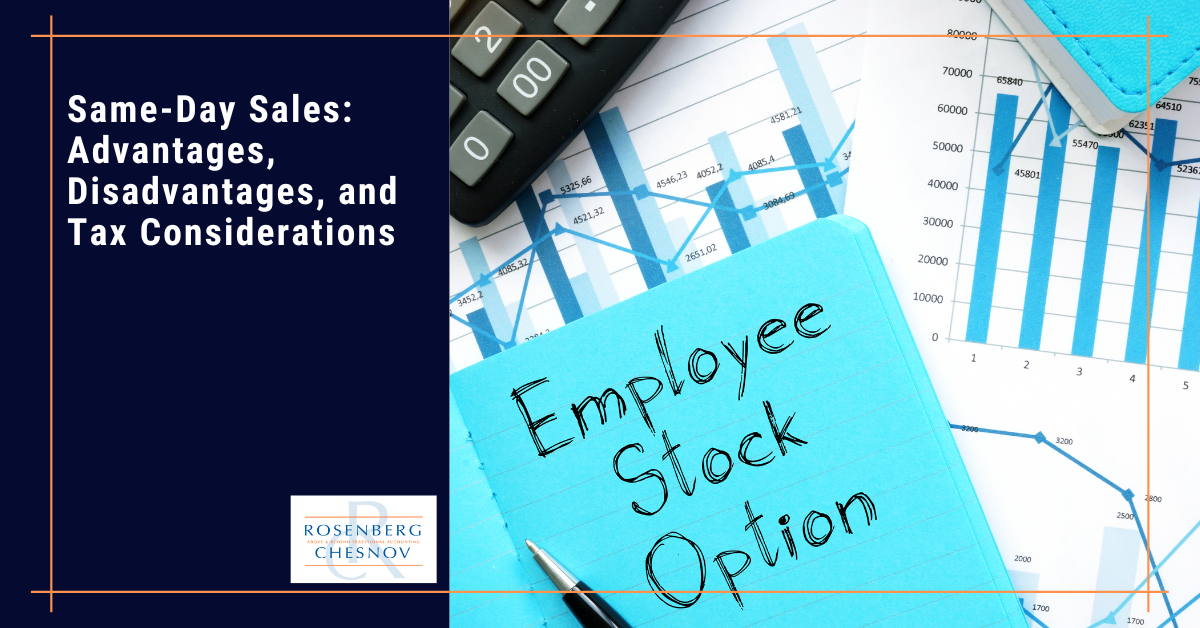

Maximize Your Green Business Tax Savings
Category: Business
Employee stock options can be a valuable aspect of a good compensation package. However, knowing when and how to exercise your options is not always so simple — and it can be expensive.
If you don’t have the cash to cover the expenses of your options exercise out-of-pocket, you may still be eligible for a cashless exercise, also known as a same-day sale.
When an employer grants a stock option to you, you are often eligible for this type of transaction in which you simultaneously exercise the option and sell the stock. As a result, you receive the cash value of the difference between the exercise price and the stock value without paying for the shares upfront.
There are drawbacks to this strategy, including high tax rates, so you must understand whether or not it is the right move for your situation.
Read on below to learn about the pros and cons of same-day sales and what you should keep in mind for tax time.


A common way for companies to attract and retain employees, stock options are a form of equity compensation that allows employees the opportunity, if they choose, to purchase shares in the company at a predetermined price.
If you work for a small startup, then getting stock options can be an excellent incentive for helping the company grow. They may even become more valuable than your salary one day, as in the case of the so-called “Microsoft millionaires,” former employees who accepted stock options in the early days of Microsoft and subsequently became wealthy when the company took off.
There are two basic categories of employee stock options (ESOs):
The employer determines the type of option offered to an employee, and the main difference between these two categories is how the IRS treats them for tax purposes.
Qualified stock option plans offer tax advantages and must comply with specific IRS rules. Most statutory stock options do not produce any immediate taxable income because you must the stock to make money off of your option.
Therefore, most qualified stock option plans require you to purchase the stock and hold it for at least one year before selling, after which any gain on the sale is subject to favorable capital gain tax rates.
Nonqualified stock options have fewer restrictions than qualified stock option plans. For example, the granting of the option is only taxable when its fair market value can be easily determined (for example, if it is already being traded on an exchange).
However, this is not usually the case, so no tax typically results from this event.
If you purchase stock at a discount under a nonqualified stock option plan, the bargain element (the difference between the option price and market value) is taxable to you as wages at the time you exercise the option.
Another important point: the term “nonqualified stock option” is a technical term describing certain types of stock options granted to employees. The term refers to how the IRS taxes the gain, not to the legitimacy of the transaction.
Generally, stock options include a predetermined price-per-stock, or exercise price, which is guaranteed and unaffected by market fluctuations; there is an opportunity for the option holder to profit if the market value of the stock increases.
For example, if your company offers you stocks at an exercise price of $10 per share, and the market value of the stock later skyrockets to $200 per share, you can exercise your option to buy the stock at $10 per share, then sell it at $200 for a nice $190 profit per share.
Of course, in order to exercise your option in the first place, you need to have $10 per share that you are willing to spend upfront. That may not sound like much, but it can add up fast. If you have one hundred shares, for example, you will need $1,000 in order to exercise.
Furthermore, as the share price increases, so do the investment and risk for the option holder. That is why a cashless exercise, or same-day sale, can come in handy.
A cashless exercise is when the exercising of an option and the sale of the stock are combined into one transaction, thus eliminating the need to first purchase the shares by using the profit of the sale to cover the cost. This is usually facilitated by a brokerage firm, which essentially extends a loan to the option holder and uses a portion of the proceeds of the sale to repay themselves for the loan.
From the point of view of the option holder, they simply receive the difference between the share price and the sale price. To demonstrate how it works, let’s continue to use our example from above. If you have the option to buy one hundred shares at $10 per share, and the market value of the stock is now $200 per share, a cashless exercise would yield you a $19,000 payout without having to put up your own cash.
It’s a simple, convenient, and low-risk strategy. However, it is not perfect.
If the idea of a same-day sale or cashless exercise sounds too good to be true, you’re right. There are some major drawbacks you’ll need to keep in mind before deciding whether or not this is the right strategy for you.
First, the “bargain element,” which is the difference between the exercise price and stock value, is taxable to you as wages at ordinary income rates, which can be as high as 52.65% if you live in California, factoring in both federal and state taxes.
Second, if you plan to use a cashless exercise, you will need to stay with the company until the IPO or acquisition. Otherwise, if you leave sooner, you will have to exercise your stock options upon your departure. Considering how long it takes for many startups to exit, a cashless exercise may not be possible for many employees.
As the high tax rates can be one of the most expensive and unexpected aspects of a same-day sale, it’s important to understand in advance that your profit may be significantly minimized.
On the other hand, if you exercise your option and wait at least one year before selling, you will be able to take advantage of a lower long-term capital gains rate, thereby increasing your gains. Likewise, if you believe your company’s stock value is likely to increase very quickly, it may be advantageous to exercise your option early. It all depends on your circumstances.
Another tax consideration to keep in mind when considering a same-day sale: due to an unusual quirk, the proceeds of the sale are reported to you twice — once as taxable wages and again as proceeds from a stock transaction. Every year, taxpayers get bills for a balance due from the IRS because they did not properly report proceeds and basis from stock options in addition to their income on Form W-2.
Drawbacks aside, there are nevertheless excellent reasons to consider a same-day sale. If you don’t have the funds to buy your shares upfront, or you don’t want to risk losing your investment if the company does not successfully exit, you may want to ask your financial advisor if a cashless exercise is the right choice for you.
If you are a client and would like to book a consultation, call us at +1 (212) 382-3939 or contact us here to set up a time.
If you aren’t a client, why not? We can take care of your accounting, bookkeeping, tax, and CFO needs so that you don’t have to worry about any of them. Interested? Contact us here to set up a no-obligation consultation.
Interested in receiving updates in your mailbox? Check out our newsletter, full of information you can use. It comes out once every two weeks, and you can register for it below.
Send us a message and we will contact you as soon as possible.
Jeff Coyle, CPA, Partner of Rosenberg Chesnov, has been with the firm since 2015. He joined the firm after 20 years of business and accounting experience where he learned the value of accurate reporting, using financial information as a basis for good business decisions and the importance of accounting for management.
He is a diligent financial professional, able to manage the details and turn them into relevant business leading information. He has a strong financial background in construction, technology, consulting services and risk management. He also knows what it takes to create organizations having built teams, grown companies and designed processes for financial analysis and reporting.
His business experience includes:
Creating and preparing financial reporting, budgeting and forecasting.
Planning and preparation of GAAP and other basis financial statements.
Providing insight on financial results and providing advice based on those results.
Jeff also has a long history of helping individuals manage their taxes and plan their finances including:
Income tax planning and strategy.
Filing quarterly and annual taxes.
Audit support.
General financial and planning advice.
Prior to joining the firm in 2015, Jeff was in the private sector where he held senior financial and management positions including Controller and Chief Financial Officer. He has experience across industries, including construction, technology and professional services which gives him a deep understanding of business.
Jeff graduated from Montclair State University, he is a CPA and member of the American Institute of Certified Public Accountants, New York State Society of Certified Public Accountants and New Jersey State Society of Public Accountants.
Jody H. Chesnov, CPA, Managing Partner of Rosenberg Chesnov, has been with the firm since 2004. After a career of public accounting and general management, Jody knows the value of good financials. Clarity, decision making, and strategy all start with the facts – Jody has been revealing the facts and turning them into good business results for more than three decades.
He takes a pragmatic approach to accounting, finance and business. His work has supported many companies on their path to growth, including helping them find investors, manage scaling and overcome hurdles. His experience and passion for business reach beyond accounting and he helps businesses focus on what the numbers mean organizationally, operationally and financially.
He has a particular expertise in early-stage growth companies. His strengths lie in cutting through the noise to come up with useful, out of the box, solutions that support clients in building their businesses and realizing their larger visions.
Prior to joining the firm in 2004, Jody was in the private sector where he held senior financial and management positions including General Manager, Chief Financial Officer and Controller. He has experience across industries, which gives him a deep understanding of business.
Jody graduated with a BBA in Accounting from Baruch College, he is a CPA and member of the American Institute of Certified Public Accountants and New York State Society of Certified Public Accountants.
In addition to delivering above and beyond accounting results, Jody is a member of the NYSCPA’s Emerging Tech Entrepreneurial Committee (ETEC), Private Equity and Venture Capital Committee and Family Office Committee.
He is an angel investor through the Westchester Angels, and has served as an advisor for many startup companies and as a mentor through the Founders Institute.